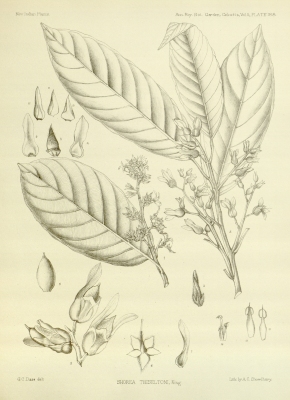Shorea singkawang
(Miq.) Burck
Dipterocarpaceae
Hopea singkawang Miq.
Pachychlamys beccarianus Ridl.
Pachychlamys thiseltonii (King) Ridl.
Shorea forbesii King ex Brandis
Shorea thiseltonii King
Common Name:
General Information
Shorea singkawang is a small to occasionally large tree[
451- Title
- Flora Malesiana Series 1
- Publication
-
- Author
- Various
- Website
- http://www.archive.org
- Publisher
- Nationaal Herbarium Nederiand, Universiteit Leiden branch
- Year
- 0
- ISBN
-
- Description
- A massive treatment of the plants of the Malaysian Archipelago. Much of it has been made available to download from the Internet
].
The tree is a source of the timber 'Dark Red Meranti', it is commonly harvested from the wild and traded internationally.
The plant is classified as 'Critically Endangered' in the IUCN Red List of Threatened Species(2013)[
338- Title
- IUCN Red List of Threatened Species
- Publication
-
- Author
-
- Website
- http://www.iucnredlist.org/
- Publisher
-
- Year
- 0
- ISBN
-
- Description
- A list of plants under threat and facing possible extinction, usually with brief details of the threats and information on habitat.
].
Known Hazards
None known
Botanical References
451- Title
- Flora Malesiana Series 1
- Publication
-
- Author
- Various
- Website
- http://www.archive.org
- Publisher
- Nationaal Herbarium Nederiand, Universiteit Leiden branch
- Year
- 0
- ISBN
-
- Description
- A massive treatment of the plants of the Malaysian Archipelago. Much of it has been made available to download from the Internet
Range
Southeast Asia - Thailand, Malaysia, Indonesia.
Habitat
Lowland mixed dipterocarp forest on well drained undulating land, sometimes by streams, at elevations below 400 metres[
451- Title
- Flora Malesiana Series 1
- Publication
-
- Author
- Various
- Website
- http://www.archive.org
- Publisher
- Nationaal Herbarium Nederiand, Universiteit Leiden branch
- Year
- 0
- ISBN
-
- Description
- A massive treatment of the plants of the Malaysian Archipelago. Much of it has been made available to download from the Internet
].
Properties
| Conservation Status | Critically Endangered |
| Other Uses Rating |      |
| Habit | Tree |
| Height | 0.00 m |
| Cultivation Status | Wild |
Cultivation Details
Not known
Edible Uses
None known
Medicinal
None known
Other Uses
The wood is a source of the timber 'Dark Red Meranti'[
338- Title
- IUCN Red List of Threatened Species
- Publication
-
- Author
-
- Website
- http://www.iucnredlist.org/
- Publisher
-
- Year
- 0
- ISBN
-
- Description
- A list of plants under threat and facing possible extinction, usually with brief details of the threats and information on habitat.
]. We do not have a specific description, but the general description of dark red meranti is as follows:-
The heartwood is pink-brown to dark red or purplish-brown, with white resin streaks; it is clearly demarcated from the 4 - 8cm wide band of sapwood. The texture is medium; the grain interlocked. The wood is moderately heavy, soft, moderately durable. It seasons well and is stable in service. It has a fairly high blunting effect and so stellite-tipped and tungsten-carbide tools are recommended, there is some risk of tearing due to the interlocked grain; nailing and screwing are good; gluing is correct. The wood has a wide range of uses including for interior and exterior panelling and joinery, light carpentry, flooring, turnery, sculpture, wood-ware and cabinetwork[
848- Title
- Tropix 7
- Publication
-
- Author
-
- Website
- http://tropix.cirad.fr/en
- Publisher
- CIRAD
- Year
- 0
- ISBN
-
- Description
- An on-line guide to the timbers of 245 species of trees.
].
Propagation
We have no specific information for this species - the information below is a general guide for the genus.
Seed - best sown as soon as possible. It does not require pre-treatment, but it is recommended to soak the seed for 12 hours prior to sowing[
]. The seeds are sown in seedbeds, where they are covered with a mixture of sand and soil (1:1) or with a thin layer of sawdust[
]. Germination of fresh seeds is usually good and rapid. About two weeks after germination, when the seedlings are 5 - 6cm tall, they are potted up into individual containers about 15 x 23cm with good drainage holes at their base[
]. It is normally recommended to use a mixture of forest soil and sand (at a ratio of 3:1) as the potting medium in order to introduce the appropriate mycorrhiza to the roots. The seedlings are placed in 50 - 60% sunlight and watered twice daily[
].
Seedlings can be planted out when 30 - 40cm tall - harden the seedlings off in full sunlight for one month prior to planting[
].
If you have any useful information about this plant, please leave a comment. Comments have to be approved before they are shown here.


 Useful Tropical Plants Database 2014 by
Ken Fern,
web interface by
Ajna Fern
with help from
Richard Morris.
Useful Tropical Plants Database 2014 by
Ken Fern,
web interface by
Ajna Fern
with help from
Richard Morris.